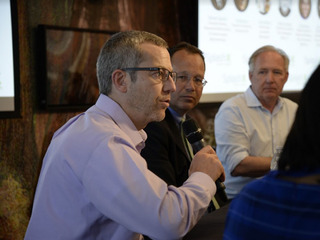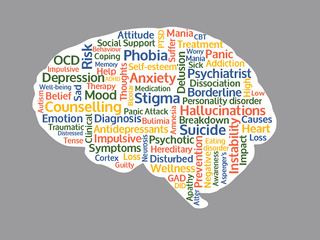

Earlier this year, Vator and HP’s held a salon called SplashX Invent Health: Mental and Behavioral Health, in which entrepreneurs and investors discussed what is happening both in terms of technology and investments in the mental and behavioral health space. What we found was that it’s a space that is growing quickly, with the number of companies getting funding, and the amount being invested, both rising steadily in recent years.
(HP and Vator’s next event – “Vitality: Lifestyle as a drug” is on Dec. 13 at HP headquarters in Palo Alto, Ca.)
As with anything happening in the health sector in the U.S., it’s the insurance companies that are playing a big role, as they determine what patients can and cannot access. Accordingly, those companies are taking a more active role in the mental and behavioral space as well.
That is certainly true of Cigna, which has been entering into numerous partnership with behavioral and mental health startups in order to give its members access to a broader range of services. Earlier this month, Cigna announced it was collaborating with Happify Health and Prevail Health, adding their digital platforms, Happify and iPrevail, to its offerings. Then, last week, it also began a pilot program with Annum Health, a company that combats the problem of alcohol addiction by using technology, with a mobile-first platform.
I spoke to Eva Borden, Senior Managing Director of Behavioral and Medical Solutions at Cigna, about how she is seeing the conversation around mental health changing, what is driving Cigna to invest in the space and what technologies are emerging to make mental health easier to access.
VatorNews: Tell me a bit about yourself, your background and your role at Cigna.
Eva Borden: I’m the Senior Managing Director for Behavioral and Medical Solutions at Cigna. I am responsible for designing solutions for medical and behavioral care and this includes creating stronger connections between these two areas. The behavioral focus includes network advancements, clinical programs, strategy, product and digital solutions.
VN: It’s great to be able to talk to someone who has your experience in this space. How important is behavioral and mental health to Cigna? What kind of opportunities do you see in this space?
EB: The place that I would start is with our mission to improve the health, the well-being and the sense of security of the people that we serve. Many people assume that it’s physical health because when you think about going to a doctor the visit often focuses on the physical.
We’ve found it’s becoming so much more important to reconnect the mind and the body. To reinforce that, as human beings, we’re bodies, we’re minds, and we’re social creatures. We have networks of people and influences around us. If you think about why Cigna is really passionate about this space, it’s because we understand that we have to address the needs of the whole person in order to effectively help someone show up at work as the best version of themselves.
VN: What kind of opportunities do you see in the behavioral and mental health space?
EB: According to the CDC, only 17 percent of adults in the U.S. are in optimal mental health, which means 83 percent of us have an opportunity to improve our mental health.
We need to think of mental health as mental well-being with the end goal of being our very best selves every day. In order to do that we have to acknowledge what’s happening in the mind as well as in the body. For example, I can talk to friends and say, “I need to exercise more or eat healthier,” but we’re not saying, ‘I’ve had a hard day. How do I cope with the stress? How do I build my resilience?’
This is an important area of focus for Cigna because to improve health and well-being, we have to realize that people are a combination of their mind, their body and the people around them. We need to be there for that whole person.
VN: I’ve noticed there’s more openness around this topic in the last five years or so, after the suicides of Robin Williams and Anthony Bourdain. Also, because of the debate over guns. Do you also see that conversation changing?
EB: I’ve definitely seen the conversation changing and the willingness of people to talk about mental health and well-being. I think there’s been latent mental health needs in our community for a really long time and now more people are able to have the conversation more readily.
I appreciate some of the younger generations that are more willing to be bold and say, ‘I have something I need help with, how do I go about getting it?’ It’s having more open conversations about suicide, making it easier to say, ‘I’m having a hard time, what do I do about it? How do I talk about it?’ It’s also the acknowledgment of employers and others being able to say, ‘If you need help, this is where you can go.’
In addition, the emergence of digital behavioral health has helped elevate the conversation by making care more accessible. Over three years, the number of companies focused on digital behavioral health has grown from 5,000 to over 10,000 allowing more people to seek help in the privacy of their own house. Before this emergence seeking help meant talking to their doctor or get an appointment with a therapist. It meant leaving work, which could feel obvious and bold. Now, help is available in much more private ways.
VN: What are some of the features and products that Cigna offers around behavioral and mental health?
EB: Cigna has been focused on providing a customer experience that meets the needs of how that person wants to seek care. We are aware that not everybody wants to seek care in the same way. To demonstrate how we’re doing this, I’ll highlight a few examples.
One of the areas I’m really excited about are the collaborations with some of our accountable care organizations. We are encouraging them to embed behaviorists within their practices. Imagine a PCP that can say, ‘May I introduce you to my behavioral health colleague down the hall?’ Maybe the person has therapy needs, but the behaviorist can address social, environmental or other needs.
Another example is to allow people to access behavioral care in the convenience and privacy of their home. Since January 2017, we have been expanding our ability to provide virtual behavioral services. Think about someone who struggles with severe depression. For that person getting out of bed and leaving their house can be a tremendous feat. It takes lot of courage to do that. Just like you would use any of our standard networks, you can video with your provider and get care as if you were sitting with them face to face.
As we continued to advance, we wanted to provide digital cognitive behavioral therapy with peer support. That’s where the partnership with Prevail came into place. There are people who want access care, but may not be ready to video conference for an hour with a therapist. They are willing to seek the care through digital tools and connect with peers.
Finally, when I think about the 83 percent of people who are not at optimum mental well-being, they may just need to build their resilience. That’s where Happify can help. These are people who may say, ‘I don’t need to see a provider, but I need help coping with stress. I’m having a hard time bouncing back after I keep fighting with my teenager, what do I do?’
In summary, we are looking across all of these needs and asking ourselves; ‘How and where does someone want to seek care? How do they want to get help? And how can we be present and available in all those places that they want to seek care?’
VN: As you said, the number of companies in the behavioral and mental health space has doubled. So what was it about Happify Health and Prevail Health that made you choose those two companies to partner with in particular?
EB: Happify and Prevail actually answer very different needs. Happify is helping us address resilience. The person who doesn’t necessarily need treatment, but needs some help coping with stress. We had a chance to pilot with some clients on Happify and we got very successful customer satisfaction rates.
We decided to partner with Prevail because we wanted to offer digital, cognitive behavioral therapy with peer support. For someone struggling with anxiety knowing they not alone is a really big deal.
VN: Can you share the results of the Happify pilot? Do have any hard numbers on how it was successful?
EB: Most of the improvement we saw really focused on the customer experience and how customers felt about it. We focused on, ‘How can we help someone feel good to be their best self to show up at work?’
Measurement is challenging in behavioral health. There’s no amount of blood, urine or tissue samples that can tell us someone is measurably better. In diabetes, we can take their HbA1c. If we want to measure if someone’s level of depression, we have to rely on self-reported data.
We are looking more closely at value of integrated benefits. Cigna recently released a study that shows there is considerable improved medical savings when you combine medical, pharmacy, and behavioral benefits and corresponding customer support.
VN: Cigna also recently partnered with Annum Health for its solution to ween people off of alcohol. How did that come about?
EB: I was extremely interested in Annum because they were tackling a space that wasn’t being addressed in an innovative way. With Annum, we can help people with a problem that’s growing at a rapid pace in the U.S., disproportionately among women.
People who are high risk drinkers often know they’re high risk drinkers. They’re struggling with what to do and they don’t know where to get care. One of the biggest challenges in the treatment of high risk drinking is there’s often not a good way get care without going to inpatient rehab for four weeks. That’s very conspicuous. They need to go on disability, walk away from their family and their job.
There wasn’t a middle ground for someone who says, ‘I need help but I can’t leave my life to get the help that I need because I’m still functioning despite my drinking.’ Annum combines coaching, therapy and regular digital modules to help keep people on track in the privacy of their home.
VN: Cigna had said that Annum could become part of its solution permanently if the pilot goes well. What results are you looking for to make that happen?
EB: I want to see that people are actually able to address their drinking. This can be defined as continuing to stay in a place of moderation or, should they chose, to not drink at all.
VN: What is your ultimate goal with these partnerships? What would success look like for Cigna?
EB: We know we can’t do it all and we don’t want to do it all. Partnerships like Annum, Happify and Prevail can help us improve the health and well-being of the people we serve. Through these partnerships our goal is to, first, treat the mind and body together which means behavioral health does not exist in a vacuum. As we look for ways to provide more affordable healthcare, I believe effectively addressing behavioral health is paramount to controlling medical trends. It goes back to what I said at the beginning: you cannot disconnect the mind and the body and be successful.
Second, every year, we’re focused on how we can continuously increase the percentage of people who are actually getting the care they need. One in five adults has a diagnosable mental health condition, yet only a fraction of those are actually diagnosed. I would love to get to the place where those who need the care are getting the care.
And, third, to drive the best customer experience by meeting our customers with what they need, when and how they need it.
VN: What other types of products do you hope to offer in this space in the future? What other technologies do you see helping to improve behavioral and mental health?
EB: We can’t afford to let behavioral be siloed from medical care because it will continue to perpetuate the same problems. If you only treat the mind and you ignore the body or if you only treat the mind and you ignore the people around you; then it’s still not going to accomplish what we want.
I am interested in technologies that help medical providers more closely align with behavioral providers. Many times providers see people in crisis, but these patients aren’t saying, ‘I think I’m going to kill myself.’ They’re going to say, ‘I’m tired, I don’t feel well. There’s just something not right, can you help me?’ I am interested in technologies that can be supportive of connecting medical and behavioral providers to address these needs.
In addition, there’s technology emerging to help connect people with safety and social needs to the resources available in their community. This could include providing transportation, food or electricity. To effectively support those who have physical and mental needs, we need to address their safety and security needs too.
Finally, there are technologies emerging that can transform how we interact and diagnose mental health. If you go back to what I said about the challenges with evaluation, that you can’t take any blood, urine or tissue samples to effectively diagnose mental health conditions, but imagine technologies that could evaluate whether or not I have depression, anxiety or another condition based on the words I used and how I talk. Imagine technology that enabled someone to help diagnose me based on my phone interactions, how I typed or my response times.
VN: That interesting but it also makes me wonder how you balance out privacy with the need for help. Someone might hear about the technology you just mentioned and say, ‘That’s really creepy.’ So how do you make sure to always respect privacy?
EB: At Cigna, we take privacy very seriously. In mental health and substance abuse, there are currently significant level of privacy protection event beyond HIPPA. As technology and companies evolve, we must continue to ensure privacy is protected.
VN: Is there anything else that I should know about Cigna or your efforts in this space?
EB: We are committed to continue delivering innovative solutions to address the spectrum of mental well-being needs. We all need some level of mental health support because, at a baseline, everyone gets stressed.
As we dig further into the spectrum of mental well-being, we are looking at micro-communities with very unique needs. They need to be approached in very different ways because they seek and access care differently. For example, we’re looking at how we can meet the needs of caregivers who are trying to care for parents and children. We are spending time understanding veterans and currently offer a helpline to any veteran. We are exploring how we interact with first responders who are running to crisis and not running away from it.
We are pursuing all these efforts as part our commitment to helping our customers get the care they need, when they need it and how they want to access it.



























